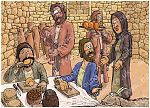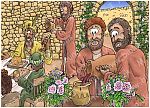Bible Cartoon: John 02 - Wedding at Cana - Scene 02 - Jars filled with water
Click on Add to cart button below shopping cart.
Purchased Bible Cartoons do not have watermarks. Links to Cartoons provided on email once purchase is completed.Bible Book: John
Bible Book Code: 4300200701
Scene no: 2 of 4
Bible Reference & Cartoon Description
John 2:6-7 (ANIV)
6 Nearby stood six stone water jars, the kind used by the Jews for ceremonial washing, each holding from twenty to thirty gallons. [1] 7 Jesus said to the servants, “Fill the jars with water”; so they filled them to the brim.
[1]
Greek, two to three metretes (probably about 75 to 115 litres).
DRAWING NOTES:
TIME OF DAY:
Unspecified by the Bible narrative. I have set this scene in the mid afternoon (a few moments after the previous scene).
LIGHTING NOTES:
The sun (unseen & on the right) is high in the sky, casting shadows to the left of figures & objects.
CHARACTERS PRESENT:
Servants.
RESEARCH/ADDITIONAL NOTES:
This scene shows servants filling the 6 large jars (mentioned in verse 6) with water from an underground water cistern. Rain water was often stored (in Biblical times) in large, man-made underground caverns (aka cisterns). They had a clay or wooden covering, which can be seen in my scene leaning up against the back wall. Notice that the two servants filling one of the jars are using an iron-bound wooden bucket, on a rope, to dip out the water, through a wooden aperture in the ground (that leads to the water cistern below).
I believe the stone water jars were pretty large (to hold 75-115 litres). research shows that 75 litres of water weighs 165 pounds (75 kilograms), whilst 115 litres weighs 253.5 pounds (115 kilograms). That is a lot for one man to carry, hence I have drawn the servant in the right foreground (who is carrying a stone water jar filled with water) with an expression of extreme exertion & struggle!
Here is the scene without the figures in the foreground.

Background of John 02 – Wedding at Cana – Scene 02 – Jars filled with water
Click on the colour bar below to view/buy this Background:
Background of John 02 – Wedding at Cana – Scene 02 – Jars filled with water
Notice that the background is quite similar to the previous scene, but scene from an position closer to the right hand wall.
There is a good article in “The Way” magazine, which explains how water was stored in underground cisterns in Bible times. Part of the article regarding the nature of cisterns is included below. I am particularly pleased that I chose to draw the cistern in an enclosed courtyard of the groom, even before reading the article!
“A cistern can be described as an underground receptacle for collecting rainwater. This rainwater is collected from the runoff from roofs or through drains. In Bible times, people that had cisterns in their homes usually dug them in their enclosed courtyard. This protected the cistern and its precious water from outsiders. A stone or wooden cover placed over the opening would keep the cistern clean until the rains came. This cover would also keep the water clean and prevent people and animals from falling in.
Cisterns could be hewn out of rock or dug out of clay. They were often bell- or pear-shaped and had a small opening at the top. Early cisterns often became dry and cracked before the rains came. Then they would no longer hold water. But about the time of Israel’s conquest of Canaan, the invention of limestone plaster made it possible to line the cisterns, making them waterproof. Cracked cisterns could also be mended with this plaster so that they could again hold water.”
[Source: https://thewaymagazine.com/cisterns-in-bible-times/]
“The description of the stone jars indicates that they contained enough water to fill a Jewish immersion pool used for ceremonial purification. Although Pharisees forbade storing such water in jars, some Jews were less strict; thus these large jars were being reserved for ritual purposes. Stone jars were common because they were less likely to contract ritual uncleanness than those made of other substances.
Using the jars for another purpose would temporarily defile them; Jesus shows more concern for his friend’s wedding than for contemporary ritual.”
[Source: Bible Background Commentary]





